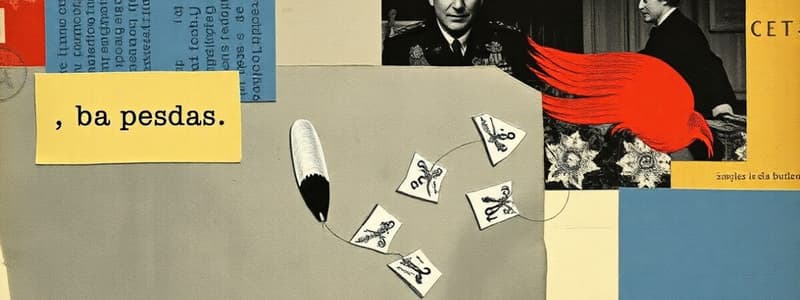Podcast
Questions and Answers
Which of the following verbs is not considered irregular in the present tense?
Which of the following verbs is not considered irregular in the present tense?
- Ser
- Hablar (correct)
- Hacer
- Tener
What is the correct conjugation of the verb 'Hacer' in the present tense for the pronoun 'yo'?
What is the correct conjugation of the verb 'Hacer' in the present tense for the pronoun 'yo'?
- Hiciste
- Hacía
- Hago (correct)
- Haces
Which of the following sentences demonstrates the use of the near future tense?
Which of the following sentences demonstrates the use of the near future tense?
- Comí
- Comeré
- Voy a comer (correct)
- Comía
In the preterite tense, which verb form corresponds to the pronoun 'ellas' for the verb 'Tener'?
In the preterite tense, which verb form corresponds to the pronoun 'ellas' for the verb 'Tener'?
Which of the following is the correct conjugation of the verb 'Ver' in the preterite tense for the pronoun 'tú'?
Which of the following is the correct conjugation of the verb 'Ver' in the preterite tense for the pronoun 'tú'?
Flashcards
Spanish: Irregular Verbs in the Present Tense
Spanish: Irregular Verbs in the Present Tense
The present tense of 'ir' (to go), 'hacer' (to do/make), 'ser' (to be) and 'tener' (to have) in Spanish. These verbs don't follow the standard conjugation pattern.
Spanish: Regular Verbs in the Present Tense
Spanish: Regular Verbs in the Present Tense
A verb conjugation pattern in Spanish where the verb ending changes based on the subject pronoun. The endings depend on the verb's ending type -AR, -ER, or -IR. The present tense is used to describe actions happening now.
Spanish: The Near Future
Spanish: The Near Future
A grammatical tense in Spanish used to express actions that will likely happen soon. It is formed by using 'ir a + infinitive' (to go to + infinitive).
Spanish: Irregular Verbs in the Preterite Tense
Spanish: Irregular Verbs in the Preterite Tense
Signup and view all the flashcards
Spanish: Regular Verbs in the Preterite Tense
Spanish: Regular Verbs in the Preterite Tense
Signup and view all the flashcards
Study Notes
Present Tense
- Irregular Verbs:
ir(to go),hacer(to do/make),ser(to be),tener(to have) have irregular present tense conjugations (forms). - Regular Verbs: Spanish verbs have predictable endings in the present tense, which change depending on the subject pronoun (yo, tú, él, ella, nosotros, nosotras, vosotros, vosotras, ellos, ellas).
- Near Future: The near future is expressed in Spanish using the present tense combined with "voy a" or "va a" + infinitive.
Preterite Tense
- Irregular Verbs:
ir,ser,hacer,ver,tenerhave irregular preterite tense conjugations (forms). - Regular Verbs: Spanish verbs have predictable endings in the preterite tense, which change depending on the subject pronoun.
Studying That Suits You
Use AI to generate personalized quizzes and flashcards to suit your learning preferences.



